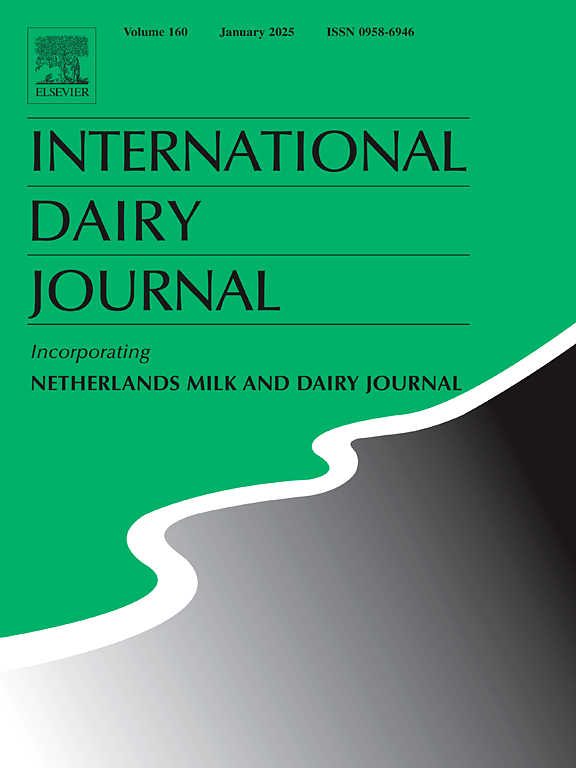Emulsification of milk fat and skimmed milk curds – Effect of temperature on rheological properties and structure of emulsion gels at different length scales
IF 3.1
3区 农林科学
Q2 FOOD SCIENCE & TECHNOLOGY
引用次数: 0
Abstract
There is a need to develop innovative cheese processes to meet consumer demands and improve production efficiency. In this study, rennet skimmed milk curds (SMC), and butter were emulsified using a thermo-mechanical process at temperatures between 70 and 90 °C. The composition, rheological properties, and microstructure of the emulsion gels were analysed up to 2 weeks of storage. Confocal laser scanning microscopy (CLSM), Small angle X-Ray Scattering (SAXS) and Low-Field Nuclear Magnetic Resonance (LF-NMR) were used to understand the gel structure. The results demonstrated that the thermo-mechanical process developed was successful in creating stable emulsion gel at 85 °C. Temperatures exceeding 85 °C led to water and fat loss, reduced fat droplet size, leading to a more compact protein network. Emulsion gels behaved as weak solid viscoelastic materials and tan δ decreased at temperature >85 °C. Lower temperatures (70 °C) lead to oiling off and incomplete gel network formation.
乳脂和脱脂乳凝乳的乳化。温度对不同长度尺度乳化液凝胶流变特性和结构的影响
有必要开发创新的奶酪工艺,以满足消费者的需求并提高生产效率。在这项研究中,凝乳酶、脱脂乳凝乳(SMC)和黄油在70至90℃的温度下使用热机械工艺乳化。在储存2周后,对乳液凝胶的组成、流变特性和微观结构进行了分析。采用共聚焦激光扫描显微镜(CLSM)、小角x射线散射(SAXS)和低场核磁共振(LF-NMR)对凝胶结构进行了研究。结果表明,所开发的热机械工艺可以成功地在85℃下制备稳定的乳液凝胶。温度超过85°C导致水分和脂肪流失,脂肪滴大小减小,导致蛋白质网络更紧密。乳化凝胶表现为弱固体粘弹性材料,温度为85℃时tan δ降低。较低的温度(70°C)会导致脱油和不完整的凝胶网络形成。
本文章由计算机程序翻译,如有差异,请以英文原文为准。
求助全文
约1分钟内获得全文
求助全文
来源期刊

International Dairy Journal
工程技术-食品科技
CiteScore
6.50
自引率
9.70%
发文量
200
审稿时长
49 days
期刊介绍:
The International Dairy Journal publishes significant advancements in dairy science and technology in the form of research articles and critical reviews that are of relevance to the broader international dairy community. Within this scope, research on the science and technology of milk and dairy products and the nutritional and health aspects of dairy foods are included; the journal pays particular attention to applied research and its interface with the dairy industry.
The journal''s coverage includes the following, where directly applicable to dairy science and technology:
• Chemistry and physico-chemical properties of milk constituents
• Microbiology, food safety, enzymology, biotechnology
• Processing and engineering
• Emulsion science, food structure, and texture
• Raw material quality and effect on relevant products
• Flavour and off-flavour development
• Technological functionality and applications of dairy ingredients
• Sensory and consumer sciences
• Nutrition and substantiation of human health implications of milk components or dairy products
International Dairy Journal does not publish papers related to milk production, animal health and other aspects of on-farm milk production unless there is a clear relationship to dairy technology, human health or final product quality.
 求助内容:
求助内容: 应助结果提醒方式:
应助结果提醒方式:


